Ikkyo Complete 7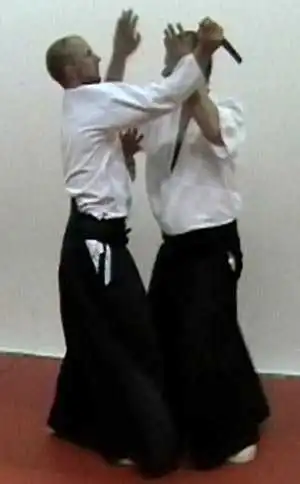 Tantodori — Defense against knife attacksTantodoriTantodori (also called tankendori) aikido techniques against knife attacks, should be trained with respect for the difficulty involved, also with attention to the self defense aspects. On these video clips, a wooden tanto is used. Below are texts and video clips on ikkyo against tanto. For tantodori in general, see here: tantodori
TantodoriTantodori ikkyo, omote and ura, on all the attack forms explained below. Many more aikido videos on my YouTube Channel.
Here, uke's wrist is grabbed from below, after the ukenagashi parry. It can also be done from above, in a gokyo manner — but then it is essential to grab at the right moment, or tori risks grabbing the blade. Because the hand is wider than the wrist, it is not so difficult to grab correctly. The gokyo style beginning is also risky because you don't have your arm between uke's tanto and your body. With the ukenagashi parry, you use your arm to ward off the knife attack. When you step forward for the ikkyo, make sure to have uke's armed hand by your side and not in front of you. You put yourself between uke's body and hand, close to uke's arm, to be able to resist if uke tries to withdraw the arm. This is true for both omote and ura. Make it a reflex always to check the knife visually, before the disarming. Otherwise you might grab it in a risky way. There are several techniques for disarming. Maybe the safest one is from the standing pinning position at the end of kotegaeshi (see here: kotegaeshi). The disarming on this ikkyo video clip is reasonably safe, if done correctly. Don't grab the blade, but use your hand as sort of a fork. Push the tanto in a small circle, not pulling it upward at all. Your other hand should control uke's arm firmly, right above the elbow. Your outer knee controls uke's wrist. For more details about disarming in ikkyo on tantodori, see here: tantodori ikkyo Both omote and ura are on the video clip.
Shomenuchi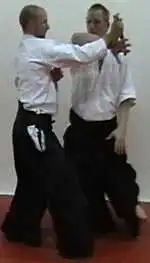 Ikkyo on shomenuchi is done quite similarly to how it's done on tsuki above. Start with an ukenagashi parry, as you make a taisabaki entrance. When you move forward for the ikkyo, make sure to hold uke's armed hand to the side of your body and not in front of you. See chudan tsuki above for additional details.
Ikkyo on shomenuchi is done quite similarly to how it's done on tsuki above. Start with an ukenagashi parry, as you make a taisabaki entrance. When you move forward for the ikkyo, make sure to hold uke's armed hand to the side of your body and not in front of you. See chudan tsuki above for additional details.The tanto can be held in two different ways, in the shomenuchi attack — either with the blade pointing down or pointing forward, that is with a straight or a reversed grip. The ikkyo technique should be done so that it protects from both attack forms. I prefer the reverse grip, as shown on this video clip, since it makes more sense for uke to attack this way. The disarming is done with the same technique as in tsuki above, but here the circle goes the opposite way. Remember always to check the tanto visually before disarming — otherwise you might grab it incorrectly. For more details about disarming in ikkyo on tantodori, see: tantodori ikkyo Both omote and ura are on the video clip.
Yokomenuchi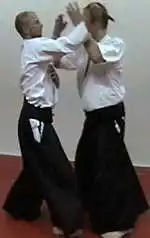 On the tantodori yokomen attack, gokyo is the typical technique to do, ending with the gokyo disarming, where uke's arm and hand form a Z. Here, though, it's ikkyo. Anyway, you can use a gokyo style grip on uke's arm when doing the ikkyo, but hardly also the gokyo disarming — if you're to stick with the ikkyo. On this video, the gokyo grip is not used, but an ukenagashi parry and a grip from below on uke's arm — same as with the techniques above. For ikkyo, I find this more trustworthy.
On the tantodori yokomen attack, gokyo is the typical technique to do, ending with the gokyo disarming, where uke's arm and hand form a Z. Here, though, it's ikkyo. Anyway, you can use a gokyo style grip on uke's arm when doing the ikkyo, but hardly also the gokyo disarming — if you're to stick with the ikkyo. On this video, the gokyo grip is not used, but an ukenagashi parry and a grip from below on uke's arm — same as with the techniques above. For ikkyo, I find this more trustworthy.I use the same taisabaki entrance and block as in unarmed yokomenuchi, katatedori, katadori, et cetera. It's good to make your initial moves as generally applicable as possible, or you will have a hard time developing practical reflexes. The tanto can be held in two different ways, in the yokomenuchi attack — either with the blade pointing down or pointing forward, that is with a straight or a reversed grip. The ikkyo technique should be done so that it protects from both attack forms. I prefer the reverse grip, as shown on this video clip. Notice that tori enters well inside the aim of uke's tanto thrust, and the block puts tori's arms as protection between tori's body and the knife. Tori's hand by uke's wrist is pushing in uke's forward direction, to get uke off balance. Tori's other hand makes atemi to uke's face. Tori should keep the elbows low, for maximum protection of the body. In both omote and ura, tori enters on the omote side of uke. Otherwise it is quite difficult to make the ikkyo turn of uke's arm. The sweeping arm move, by which tori catches uke's arm for the ikkyo, is also a block in case uke attacks with the other arm. It should be done in movement, not standing still at the spot. Make sure to hold uke's armed hand to your side and not in front of you — as always in tantodori ikkyo. The disarming is done in the same way as for shomenuchi and tsuki above. Remember to check the tanto visually before doing it. For more details about disarming in ikkyo on tantodori, see: tantodori ikkyo Both omote and ura are on the video clip.
Ushiro chudan tsuki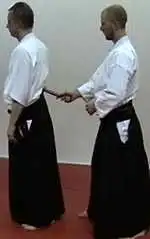 This attack form, ushiro chudan tsuki, is not basic in aikido, but fun to try. On this video clip it is done so, that uke holds the tanto to tori's back, ready to strike if tori moves. Therefore, tori has to do the taisabaki turn quickly, without any tell-tale movement before it. That's good to train.
This attack form, ushiro chudan tsuki, is not basic in aikido, but fun to try. On this video clip it is done so, that uke holds the tanto to tori's back, ready to strike if tori moves. Therefore, tori has to do the taisabaki turn quickly, without any tell-tale movement before it. That's good to train.Just by holdning the arms in a natural way by the sides of the body, tori will parry the tanto when spinning around. The only thing needed is to extend the arms a little from the body when turning. It's not necessary to first check with what hand uke holds the tanto — if it's the one hand, you can do ikkyo, and if it's the other you can do for example kotegaeshi or kokyunage. When you turn around, don't worry too much about how to move the feet. If you spin around decisively, remaining in your center, the feet will take care of themselves. Make sure not to move too far away from uke in the turn, or you will have trouble following up with the ikkyo. After the turn you can grab uke's arm from above, like in gokyo, or from below. I use the latter, just like in the above techniques. That is the swiftest, after the turn and parry. The disarming is done in the same way as for the techniques above. Remember to check the tanto visually before doing it. For more details about disarming in ikkyo on tantodori, see: tantodori ikkyo Both omote and ura are on the video clip.
Stefan Stenudd
IKKYO COMPLETE
AIKIDO PRACTICEIntroductionAikido Techniques — all the basic movesAttacks in Aikido
Tantodori — knife defenseAikiken — aikido sword techniquesJo 31 Kata in four directionsAikibatto sword and staff exercisesAiki — joining energiesKi exercisesAikido Video ClipsAikido PhotosMy aikido dojo in Malmö, SwedenMy aikido seminarsAIKIDO THEORYMy Aikido BioAikido GlossaryTanden, the CenterAikido InksAikido as Self-DefenseRunning a DojoAikido is TrueOsensei and EinsteinAikiWeb ColumnsAikido Books ReviewedDie deutsche Version meines Aikido-Buches onlineAikido på svenskaAbout CookiesMy Other WebsitesCREATION MYTHSMyths in general and myths of creation in particular.
TAOISMThe wisdom of Taoism and the Tao Te Ching, its ancient source.
LIFE ENERGYAn encyclopedia of life energy concepts around the world.
QI ENERGY EXERCISESQi (also spelled chi or ki) explained, with exercises to increase it.
I CHINGThe ancient Chinese system of divination and free online reading.
TAROTTarot card meanings in divination and a free online spread.
ASTROLOGYThe complete horoscope chart and how to read it.
MY AMAZON PAGE
MY YOUTUBE AIKIDO
MY YOUTUBE ART
MY FACEBOOK
MY INSTAGRAM
MY TWITTER
STENUDD PÅ SVENSKA
|
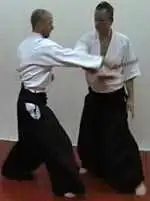
 Aikido Principles
Aikido Principles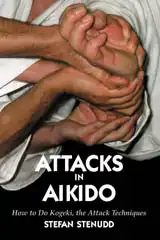 Attacks in Aikido
Attacks in Aikido Aikibatto
Aikibatto
